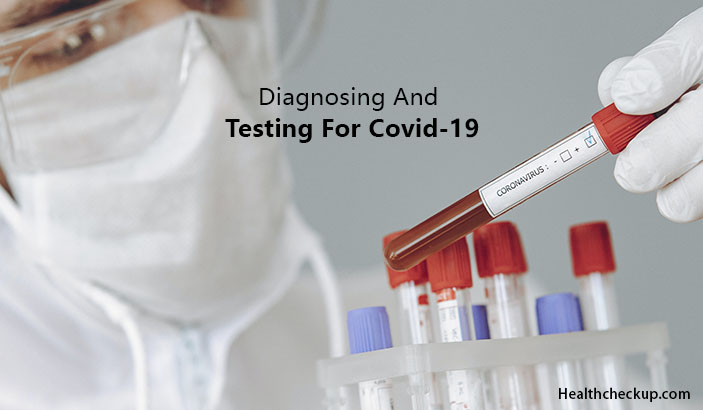The COVID-19 pandemic is still ongoing. One of the critical features in addressing the pandemic has been testing for the disease. When testing for the SARS-CoV-2, the virus that causes COVID-19, one can either test for the virus or an immune response to the virus. The testing methods that detect an active virus in the body are called antigen tests and RT-PCR tests. The testing method to determine the immune response to the virus is called an antibody test. Let us look into the details of these tests.
Diagnosis And Testing Of Covid-19
1. Antibody Tests
Antibody tests, also known as serological tests, detect antibodies in the blood sample. Antibodies are naturally produced by the immune system as a response to fight off COVID-19 infection. Antibodies can take several days or weeks to develop after the infection and may be present in the blood for several weeks or more after recovery. Antibody tests cannot be used to diagnose an active coronavirus infection but can determine whether an individual was recently exposed to the COVID-19 virus. Antibody tests can help resolve diagnostic uncertainty about a prior illness and provide important information to scientists trying to understand the extent of viral spread in a community, including the possibility of “herd immunity.”
Antibody tests can be of different types. One of the tests, known as Enzyme-Linked Immunosorbent Assay (ELISA), screens many specimens at a time.
How It Is Done
For the antibody test, the blood sample is placed on a cassette or cartridge that contains the SARS-CoV-2 proteins. If antibodies are present in the blood, they will immediately bind to the viral proteins. It shows a positive result in the form of lines.
2. Antigen Tests
Antigen tests rapidly detect specific proteins on the surface of the virus that triggers the body’s immune response. With Covid-19, the ‘spike protein’ present on the surface of the coronavirus facilitates its entry into the human cell.
How It Is Done
These tests use a nasal or a throat swab that is immersed in a solution to deactivate the virus. A few drops of this solution are then put on a test strip that contains artificially synthesized antibodies tailored to bind to the spike proteins of coronavirus. The test lines will appear in case of a positive result.
Antigen tests are faster (around 30 minutes) and less expensive compared to the molecular tests and are considered very accurate for positive results, but there are high chances of false-negative results. Hence, a molecular test is recommended to confirm a negative antigen test result.
3. RT-PCR Tests
RT-PCR is the most effective and accurate method of COVID-19 testing. These tests are based on the detection of the virus’s genetic material in a sample from the patient’s nose or throat. These tests rely on a technique called Reverse Transcription Polymerase Chain Reaction or RT-PCR for analysis.
How It Is Done
The RT-PCR test starts with a simple swab taken from a person’s throat or nose. As genetic materials coronaviruses have RNA or ribonucleic acid. The sample from the swabs contains very small amounts of RNA, which is not sufficient for testing. Hence, the single-stranded RNA molecule is converted into a double-stranded DNA molecule using an enzyme. This step is known as Reverse Transcription (RT). Specific areas in the genome are then selected that do not mutate rapidly as the virus develops and creates copies of these using the Polymerase Chain Reaction (PCR) process. This step uses primers, which are small fragments of DNA designed that bind only to the selected DNA sequence of the SARS-CoV-2’s viral genome. This process also uses probes that are fluorescently labeled DNA oligonucleotides. They are actually designed to bind downstream of one of the primers during the PCR reaction and to give a fluorescent signal during the reaction.
The sample, primer, and probe are together left in the PCR machine for the binding process to take place. A fluorescent signal marks the presence of the COVID-19 virus. The test takes around 4 to 8 hours. RT-PCR is the most common and highly sensitive test that picks up copies of the virus at very early stages of infections.
4. TrueNAT
TrueNat is a chip-based, battery-operated, and portable RT-PCR used for screening and confirmation of COVID-19. This test identifies E-gene in the SARS-CoV-2 virus that helps build a spherical envelope around the virus, and the gene for RdRp (RNA-dependent RNA polymerase) enzyme that enables the virus to replicate. The test results are available within 30 minutes as the sample preparation in TrueNAT tests is automated when compared to the traditional RT-PCR tests. Considering these tests as a confirmation for COVID-19 virus, the Indian Council of Medical Research (ICMR) approved the use of TrueNat machines.

Vasavi Attada specializes in creating content for Medical/healthcare domain. She has written articles for Indian Health Organization (IHO), American Diabetes Association, and for magazines such as India Today and Dignity Dialogue.
Vasavi Attada holds a Master’s degree in Microbiology from Bangalore University.









